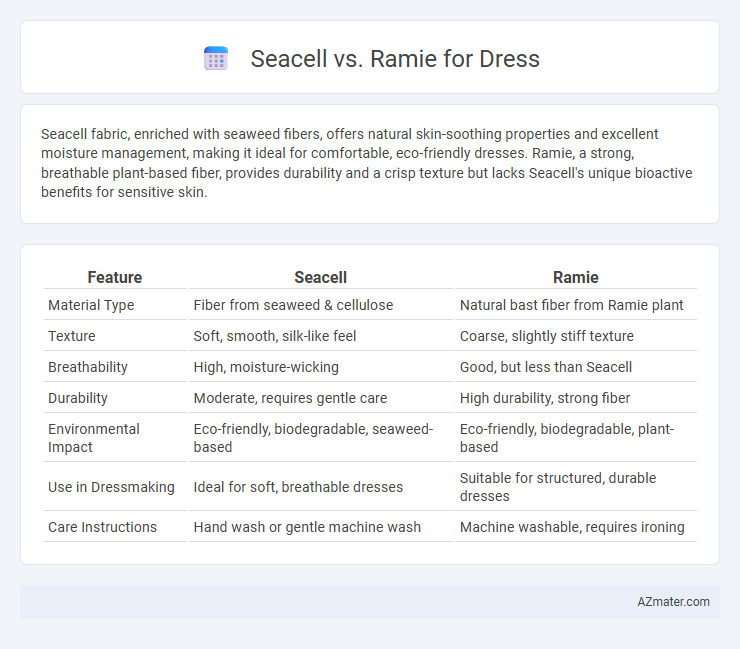Seacell fabric, enriched with seaweed fibers, offers natural skin-soothing properties and excellent moisture management, making it ideal for comfortable, eco-friendly dresses. Ramie, a strong, breathable plant-based fiber, provides durability and a crisp texture but lacks Seacell's unique bioactive benefits for sensitive skin.
Table of Comparison
| Feature | Seacell | Ramie |
|---|---|---|
| Material Type | Fiber from seaweed & cellulose | Natural bast fiber from Ramie plant |
| Texture | Soft, smooth, silk-like feel | Coarse, slightly stiff texture |
| Breathability | High, moisture-wicking | Good, but less than Seacell |
| Durability | Moderate, requires gentle care | High durability, strong fiber |
| Environmental Impact | Eco-friendly, biodegradable, seaweed-based | Eco-friendly, biodegradable, plant-based |
| Use in Dressmaking | Ideal for soft, breathable dresses | Suitable for structured, durable dresses |
| Care Instructions | Hand wash or gentle machine wash | Machine washable, requires ironing |
Introduction to Seacell and Ramie Fabrics
Seacell fabric is an innovative textile made from a blend of seaweed fibers and natural cellulose, known for its moisture-wicking properties and skin-friendly benefits. Ramie, derived from the stalks of the Chinese nettle plant, is a strong, lustrous fiber often used for its breathability and durability in dress fabrics. Both materials offer eco-friendly alternatives, with Seacell promoting skin health and Ramie providing a crisp, lightweight texture ideal for warm-weather garments.
Origins and Production Processes
Seacell fabric, derived from sustainably harvested brown seaweed blended with cellulose fibers, undergoes an eco-friendly wet spinning process that preserves its bioactive properties. Ramie, a natural bast fiber sourced from the stalks of the Ramie plant native to East Asia, requires labor-intensive harvesting followed by retting, decortication, and degumming to extract its lustrous fibers. The distinct origins and manufacturing techniques of Seacell and Ramie result in unique textures and eco-credentials valued in dressmaking and sustainable fashion.
Environmental Impact Comparison
Seacell fabric, made from sustainably harvested seaweed blended with organic cotton, offers biodegradable properties and supports marine ecosystem health, making it an eco-friendly choice for dresses. Ramie, a natural fiber derived from the stalks of the Chinese grass plant, requires less water and fewer pesticides than cotton but involves energy-intensive processing, impacting its overall environmental footprint. When comparing environmental impacts, Seacell's renewable resource base and biodegradability provide advantages over Ramie's lower water use but higher processing emissions, positioning Seacell as a more sustainable option for eco-conscious dress production.
Comfort and Wearability Factors
Seacell fabric, derived from seaweed and cellulose fibers, offers exceptional moisture-wicking and skin-soothing properties, enhancing comfort for extended wear. Ramie, a natural bast fiber, provides excellent breathability and durability but may feel stiffer and less flexible compared to Seacell, impacting overall comfort. For dresses prioritizing softness and wearability, Seacell is favored due to its smooth texture and hypoallergenic benefits, while Ramie suits more structured, long-lasting garments.
Breathability and Moisture Management
Seacell fabric, derived from seaweed-infused cellulose fibers, offers superior moisture management by actively absorbing and releasing sweat, making it ideal for dress materials in warm climates. Ramie, a natural bast fiber known for its breathability, provides excellent air circulation but tends to retain moisture longer than Seacell, potentially causing discomfort during intense heat. For dresses prioritizing all-day freshness and moisture control, Seacell outperforms Ramie in balancing breathability with effective moisture-wicking properties.
Durability and Longevity
Seacell fabric, infused with seaweed fibers, offers moderate durability with unique skin benefits but may be less resistant to wear compared to Ramie, which is a bast fiber known for its exceptional strength and longevity. Ramie's natural resistance to stretching, wrinkles, and abrasion makes it ideal for dresses requiring long-term durability and maintaining shape. Choosing Ramie for dressmaking ensures extended garment life and sustained structural integrity, while Seacell provides a softer feel but may require more careful handling to preserve its quality.
Style and Aesthetic Differences
Seacell fabric offers a smooth, luxurious drape with a subtle sheen that enhances elegance in dresses, while Ramie provides a more textured, matte finish with a slightly stiffer structure. Dresses made from Seacell often exhibit fluid movement and a gentle glow, contributing to a sophisticated and modern aesthetic, whereas Ramie's natural luster and crispness create a casual, rustic charm ideal for relaxed or bohemian styles. The choice between Seacell and Ramie significantly impacts the dress's visual appeal, with Seacell favoring refined silhouettes and Ramie highlighting natural, breathable comfort.
Care and Maintenance Requirements
Seacell fabric, infused with seaweed fibers, requires gentle care such as hand washing or using a delicate cycle with cool water to preserve its natural properties and avoid damage. Ramie, a strong natural fiber derived from the ramie plant, is more durable but still benefits from washing in cold water and air drying to prevent shrinkage and maintain fabric firmness. Both fabrics should be kept away from high heat and harsh detergents to extend the lifespan of dresses made from these materials.
Price Point and Accessibility
Seacell fabric, infused with seaweed fibers, typically commands a higher price point due to its unique bioactive properties and sustainable sourcing, making it less accessible for mass-market dress production. Ramie, a natural fiber derived from the stalks of the Chinese nettle plant, offers a more affordable and widely available alternative with good durability and breathability, suitable for budget-conscious consumers. The accessibility of Ramie fabrics in global textile markets ensures greater scalability for dress manufacturing compared to the niche, premium positioning of Seacell materials.
Best Applications for Dresses
Seacell fibers, enriched with seaweed extracts, offer excellent moisture-wicking and antibacterial properties, making them ideal for summer dresses and activewear where breathability and skin comfort are essential. Ramie fibers provide a natural luster, high tensile strength, and great wrinkle resistance, making them suitable for structured dresses that require durability and a polished appearance. For dresses combining softness and performance, blending Seacell and Ramie enhances comfort, sustainability, and fabric resilience.

Infographic: Seacell vs Ramie for Dress
 azmater.com
azmater.com